The Chertsey Oil Well
The Canterbury Petroleum Prospecting Company started drilling for oil in 1914 and it was ceased in 1921.As far as I know it was a drill bit had broken down the well and with the sandy ground around the well they were unable to retrieve it and made it impossible to continue.Probably with todays modern tools it probably would be an easy job to recover the broken drill bit.Traces of oil were found in the well people have told me that workers put it down the well as to keep their job going and also keep share holders happy and money coming in but whatever story is true if any it is purely debatable.On further research i have now found thats oil was found in Chertsey 1 which was this oil well at 420 mtrs and at the J D George 1 well which is about 10 kms south of this one and was drilled late 1960s ,oil seepages were found at 1650 mtrs.
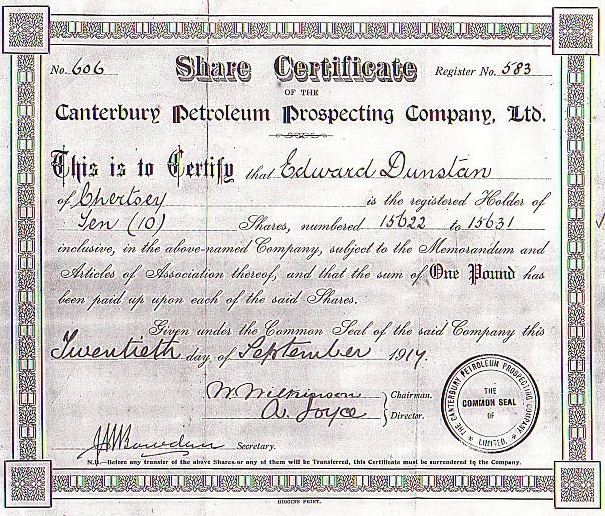

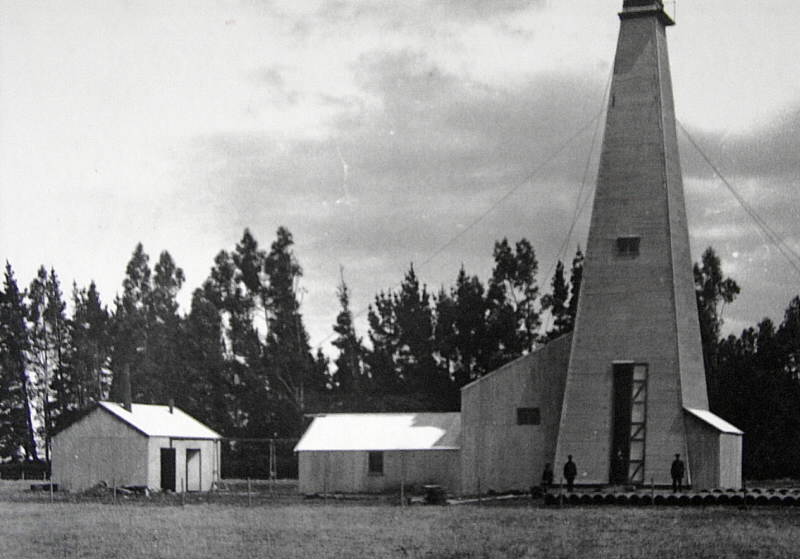 |  |
These cuttings were taken from the Ashburton Guardian
1914 1921
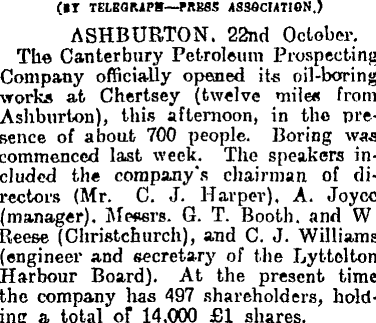 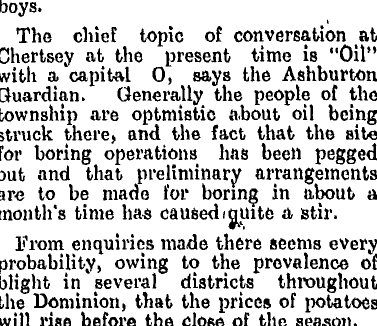 |  |
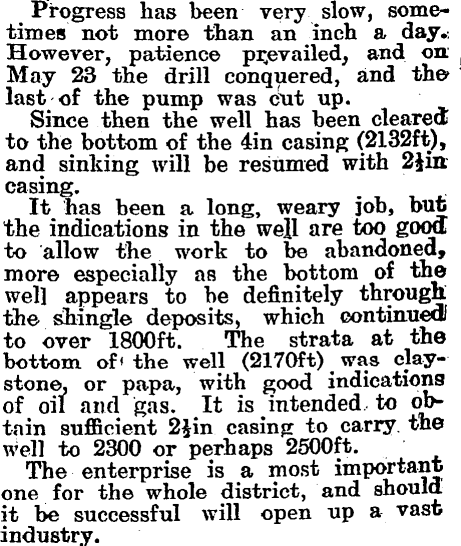
Michael Hanrahan October 25, 2011 I thank Michael Hanrahan and the Ashburton Gaurdian for this published on the 25/10/2011
Ashburton’s first citizen, William Turton, had a licence to sell petroleum products, almost from the time of his arrival in Ashburton, but petroleum products at that time were not for fuelling vehicles, but for providing light and, sometimes, heat.However, in the early 20th century cars were becoming more common, and on the horizon were farm tractors. Fuel was imported in four gallon tins, two tins in a wooden box. What was needed was a New Zealand based petroleum industry to meet the growing need.
One company determined to establish such an industry was the Canterbury Petroleum Prospecting Company. Inaugurated in August 1913, the company wasted no time in settling on a site near Chertsey as the ideal place to drill a well. Their choice of site was based on little more than a comparison of the Canterbury topography with that of successful fields elsewhere in the world.
A steam powered drilling plant worth £2000 was bought for £700 from a failed Gisborne firm, buildings, including a tower 86 feet high, were erected on Chertsey Kyle Road (then called variously Beach Road or Boundary Road) and early in October 1914 work began, halted briefly on October 23 for an official opening.
Opening day speeches dripped with optimism. The company had a concession to prospect over 250,000 acres. Almost 10,000 shares had been taken up by 497 shareholders. It was proposed not to sell more than 15,000 shares, so the return to each shareholder would be greater when oil was struck. There was talk of a second well at Ealing and a refinery at Timaru.
Over the next four years work continued, delayed only by wartime difficulties obtaining well pipe from overseas. The chance was always taken to give visiting politicians the grand tour, and frequent visits were arranged for journalists. Mud extracted from the well would be placed in water, resulting in an oily film, and the smell of gas could be detected. It all looked very positive.
In fact, a number of issues, incidents, accidents and mishaps had caused problems from Day One. Supply of casing and driven pipe caused problems, necessitating the reduction of the bore from five inch to four inch and then even further. Another problem was fine quicksand. A seven foot layer was struck at 2120 feet and it rose between the inner and outer pipes. The pipe was driven a further 12 feet but the sand between the two pipes caused so much friction no further progress could be made. Instead, drilling resumed until, at 2170 feet, on March 23, 1920 a wire rope broke and dropped a 16 foot long sand pump to the bottom, along with 500 feet of rope.
The crew managed to lift the pump 250 feet but it jammed at that point. Two 40 ton hydraulic jacks were employed to withdraw the casing but it broke 100 feet down. The lengths in that 100 foot piece were then riveted together rather than screwed and a left hand threaded die was fitted to the bottom and dropped on to the piece still in place. By turning the pipe the broken piece unscrewed at the next joint and was withdrawn and replaced. The jacks were used again, but the casing broke again at 1825 feet.
It was then decided to use the drill to break the offending pump up. This operation took months, with sometimes only two inches progress being made each day. Eventually they were successful and drilling started again, until, a further 30 feet deeper, at 2200 feet, in September 1921, quicksand again rushed in, forcing its way up nearly 1000 feet.
The company’s financial resources were exhausted, including a £1000 Government subsidy, and Canterbury Petroleum Prospecting Ltd was immediately put into liquidation. The staff were employed for a few more weeks removing as much of the casing as possible from the bore, with an estimated half of the 10,000 feet of pipe used in bore and casing being recovered.
That was the end of the Chertsey oil well. Little remains on the site today, but the Ashburton Museum holds some photos, and the company minute book is at Canterbury Museum